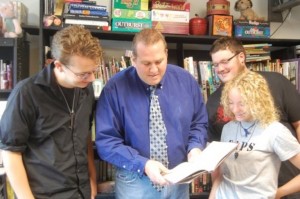I have been in Minneapolis since Thursday afternoon. Since Thursday, I have interacted with a number of educators and librarians and authors and poets and illustrators and book representatives. I have listened to them as they shared from panels. I have dined with them as they shared stories over our plates.
Over the weekend, I saw a powerful documentary by E.E. Charlton-Trujillo that is going to change practices and change lives.
Last night I hung out in a hotel lobby with A. S. King (yes. . .THAT A. S. King).
In the past twenty-four hours, I have sent two separate shipments of books that will land in the hands of readers in Room 407 and the other classroom to which we will gift books after the Thanksgiving Break.
It’s been quite an experience.
At the ALAN workshop, I have been witness to panel after panel of the authors of books we have on our shelves in southern Indiana. With each book. . .with each author. . .I keep thinking:
“_____________ would read this.”
or
“I cannot wait for ______________ to see this book.”
So, here is the question. Why are our students not reading these books? What keeps them? I saw a young man’s life begin to transform before my eyes as he related that he had only read and enjoyed Walter Dean Myers’s MONSTER as he met up-and-coming author/poet Jason Reynolds. He walked away with BOY IN THE BROWN SUIT. He left the ballroom on what will be a new step along the reading journey.
With this young man was a another holding a copy of CRENSHAW. No one was cautioning this older teen on the issue of “reading level” or “age appropriateness.” His holding the little purple book reminded me of an adult drinking grape juice from a juice box. No one tells us we cannot it. It’s actually kind of cute. And. . .refreshing.
Why are OUR students not reading these books that I have seen shared and talked about and gingerly packed into suitcases and boxes to be carried or wheeled out to the shipping office next door? They are going somewhere in the proximity of kids. . .would-be readers.
I can envision kids unpacking the the boxes that will arrive as we return to school from Thanksgiving Break. They will pull books out of the box with the same excitement that I have all weekend. I cannot wait for the big reveal to happen.
Kids will read these books.
But kids can also read our indifference to young adult literature. They will read our agendas as we talk about levels and numbers and the length of time they have to read and to finish a book. We call them the struggling readers when we are the ones who stuggle with our ability to communicate what we mean when we say reading is important.
There’s a saying within the faith community that says, “You may be the only Bible others read.”
We might revise this for the reading community to say, “You may be the only library a young person might enter into mentally, socially, and emotionally.”
We close the door to this library when we place limits upon access. . .and this includes the books we do not have in our classrooms for kids to read. Imagine if the only book you could choose on a winter’s night by the fireplace was your textbook given to you on the first day of school with the promise that it would be taken away on the last day of school.
We hang an invisible CLOSED sign on the library these readers might have entered when we have nothing to offer by way of resources and by way of recommendation.
We take down the COMING EVENTS sign when we do not invite interaction with Middle Grade and Young Adult authors when we do not seek out and solicit interaction with the authors who would and could speak to our readers in the room.
The displays don’t really look like anything anyone would take a book away from when we don’t highlight the reviews. The stars. The medals. The Awards given to these books each year.
We lead the would-be reader to assume no one is at the counter when we don’t make the time to book talk that title our students would read if we employed among the most simple aspects of Reader Advisory: Reading the books ourselves. Knowing the books. Being open to sharing these books.
We shut out the lights of Middle Grade and Young Adult literature when we devalue and we don’t talk about the books written specifically to this demographic.
Take the boards that might have been shelves and use them to block the windows. Lock the door on your way out.
And all of this indifference in Middle Grade and Young Adult Literature?
All of this willful disregard?
All of this disinterest?
Our students would read this too.
